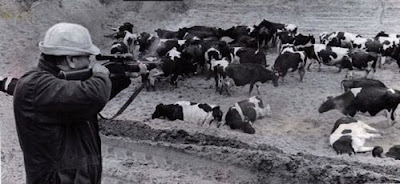Book Review: 'The Poisoning of Michigan' by Joyce Egginton
On September 20, 1973, Rick Halbert, a dairy farmer in Battle Creek, Michigan, concluded that his cows were sick.
The animals in Halbert's 400-head herd were not eating; they seemed lethargic and were not providing as much milk as they normally did.
Halbert suspected that the latest shipment of feed he was giving to his cattle, called Dairy Ration 402, might be responsible. He contacted the Michigan Farm Bureau feed mill in Battle Creek and asked if they had mistakenly substituted the magnesium oxide supplement in Dairy Ration 402 with another element, such as molybdenum or manganese.The feed mill assured him that they had not.
As Fall turned to Winter, Halbert grew increasingly desperate as his dairy herd was ravaged by illness. The animals suffered from mange, skin lesions, diarrhea, and neurological disorders. Calving season was a disaster; many calves died in utero, and the cows were too sick to expel the aborted calves.
Halbert's veterinarian tested the animals for a variety of diseases, suspecting poisoning from mycotoxins in the grain fed the animals. But the results were negative.
Facing financial ruin, Halbert - who had a degree in chemical engineering, a body of training few dairymen possessed - barraged the state agricultural laboratory and Michigan State University with requests to test the Dairy Ration 402 feed for contaminants, particularly pesticides. But sophisticated chemical tests performed on the feed were negative.
Then, in April 1974, a chemist at the USA laboratory in Beltsville, Maryland, identified reproducible peaks of a chemical contaminant in samples of Dairy Ration 402. The peaks were not associated with pesticides, which explained why they had not been detected by routine screens for the presence of those chemicals.
But when George Fries, the USDA chemist, revealed what the peaks were, Rick Halbert - and soon every farmer in Michigan - and then every resident of Michigan - realized that the disaster was just starting.....
'The Poisoning of Michigan' (363 pp, Michigan State University Press, 2009) is a very readable, often dramatic account of one of the greatest toxic disasters in the modern history of the USA, one with consequences that plague many of that state's residents even today.
[ 'Poisoning' first was published in hardback in 1980; this 2009 trade paperback features an Afterward by Devra Lee Davis, Maryann Donovan, and Arlene Blum that updates the story of the disaster. ]
As Egginton makes clear, the disaster was aided and abetted by indifferent bureaucrats, scientists, and politicians, who tried to sweep the scope of the contamination under the rug, 'only to see it come out the other side'.
I don't remember hearing about the disaster back in '73 and '74, but the news media was obviously much more localized back then and events in Michigan would not have received much coverage in the major newspapers in New York State.
I do vaguely remember advertising for the 1981 TV movie Bitter Harvest, which starred Ron Howard (who played Richie Cunningham in Happy Days), as a Michigan farmer who confronts the toxic disaster.
With the passing of the decades, the disaster in Michigan has faded from the public consciousness. But 'The Poisoning of Michigan' is well worth getting, both as a documentary of a major 70s toxic disaster, and as an engrossing book in its own right.
Facing financial ruin, Halbert - who had a degree in chemical engineering, a body of training few dairymen possessed - barraged the state agricultural laboratory and Michigan State University with requests to test the Dairy Ration 402 feed for contaminants, particularly pesticides. But sophisticated chemical tests performed on the feed were negative.
Then, in April 1974, a chemist at the USA laboratory in Beltsville, Maryland, identified reproducible peaks of a chemical contaminant in samples of Dairy Ration 402. The peaks were not associated with pesticides, which explained why they had not been detected by routine screens for the presence of those chemicals.
But when George Fries, the USDA chemist, revealed what the peaks were, Rick Halbert - and soon every farmer in Michigan - and then every resident of Michigan - realized that the disaster was just starting.....
'The Poisoning of Michigan' (363 pp, Michigan State University Press, 2009) is a very readable, often dramatic account of one of the greatest toxic disasters in the modern history of the USA, one with consequences that plague many of that state's residents even today.
[ 'Poisoning' first was published in hardback in 1980; this 2009 trade paperback features an Afterward by Devra Lee Davis, Maryann Donovan, and Arlene Blum that updates the story of the disaster. ]
As Egginton makes clear, the disaster was aided and abetted by indifferent bureaucrats, scientists, and politicians, who tried to sweep the scope of the contamination under the rug, 'only to see it come out the other side'.
I don't remember hearing about the disaster back in '73 and '74, but the news media was obviously much more localized back then and events in Michigan would not have received much coverage in the major newspapers in New York State.
I do vaguely remember advertising for the 1981 TV movie Bitter Harvest, which starred Ron Howard (who played Richie Cunningham in Happy Days), as a Michigan farmer who confronts the toxic disaster.
With the passing of the decades, the disaster in Michigan has faded from the public consciousness. But 'The Poisoning of Michigan' is well worth getting, both as a documentary of a major 70s toxic disaster, and as an engrossing book in its own right.
































































































